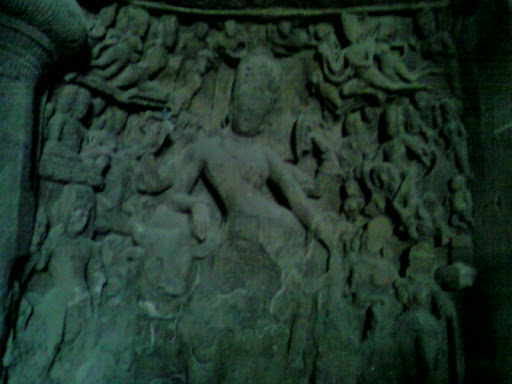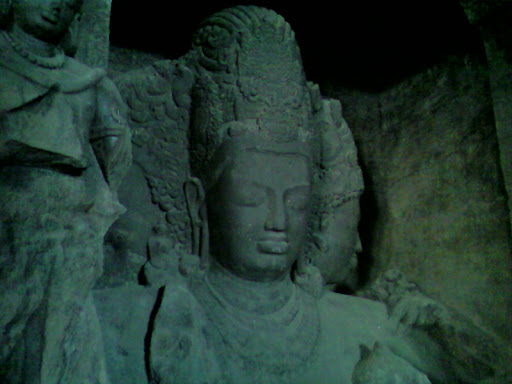A ferry takes us out to the island from the Gateway in around 45 mins, past the Naval and JNPT refuelling docks.
The harbour is a teeming carnival of every possible type of boat -Koli fishing boats like scruffy mongrels,
We pass a concrete battle station. It's made of smooth, featureless, soft-edged sloped concrete that we realize has been built to take the maximum of shelling damage from enemy ships without being destroyed, with bunker-slits and AA guns shrouded in canvas on the top.
Looks like a ghost structure; can't see anyone on it all, though they're probably watching us from inside. The contrast of bright, sund-drenched concrete, deep dark shadows, and lack of people makes it look like something straight out of Resident Evil 3: Extinction. You keep expecting to see the undead begin shambling out of the recessed bulkheads the moment you step on it.
(So sorry, but I just couldn't resist that one... :)
.
.
Elephanta Island: First Impressions
Where there is Indian Culture and History, there will be firangi tourists. And where there are Firangi Tourists, there will be The Great Indian Flea Market, an entity that I am convinced is run by some ISO9001 corporate organization. They've achieved a depth of penetration way better than the Unilevers and a standardization of look and experience better than any MacD. It's always the same blue tarps, trays, beads and statuettes, crystal, and handicraft. The only thing that changes is the subject matter of the local guidebooks and T-shirts. Even the vendors look related.
Where there are Firangi tourists, there will be domestic tourists. And where there are domestic tourists, there will be chips, snacks, peanuts, soft drinks, and packed food by the ton.
And when the Supreme Being looked down upon this, and saw what the Tourist hath wrought, She shook her head with utter exasperation, and said,
...
"LET THERE BE MONKEYS."
...
And there were.
In every variety of color, shape, size, temperament, and ingenuity.
The monkeys on the island are Bonnet Macaques (Macaca radiata), all quite similar to each other, and to Laloo Prasad Yadav.
A shock of white hair in a bowl haircut, protruding ears, the works. Some have the hair spiked upwards like Dennis Rodman for variety, or possibly to expand their markets to include the European visitor.
.
They've become so completely used to the tourist lifestyle, an entire set of learned behaviour has emerged. For example -
1. Tourists carry food, and can be enticed to share food by pathetic looks.
2. When pathetic looks don't work, hoots, snarls and bared teeth will do the trick.
3. When all fails, add a leap and a slap, and it's free meal of the day time.
Monkey antics also included, during our visit a female macaque slapping a closed bottle of Mirinda out of a hand, grabbing and scampering away, and sitting on a rock pile, steadying the bottle with her feet and opening the cap with both hands, before polishing off the bottle with an elan that would have any marketing manager scouting for brand ambassadors drooling and gibbering with desire.
.
.
There's a constant war going on between the dogs and the monkeys, and the monkeys seem to have the upper hand because they have three huge advantages - they have opposable thumbs to open packets and bottles; they have novelty value; and they can eat in trees, away from the dogs.
A young adolescent snatching a large blue plastic bag from a local and finding it weighs twice his own weight, keeping six humans at bay with snarls and growls while he rummages through it like a customs inspector acting on a tip-off.
.
To his disgust, there's nothing but warm clothes.
When not literally stuffing their faces with other people's food, the monkeys fight each other or groom, snoozing in the sun.
.
This is the life, innit?
.
He leads her back to his home, and we witness a beautiful idyllic domestic scene that must have served as the inspiration for the Sanjeev Kumar - Deven Verma starrer Angoor - two pairs of twins.
.
.
The Caves
.
Elephanta Island is a misnomer. It's actually Gharapuri Island (the place of caves) and it's just the caves that are called Elephanta, and that too by the Portugese that found the island in the 17th century. The actual caves were built between 600 to 1300 AD, under royal patronage.
The Portugese have a lot to answer for. The Elephant statue which gave the place it's name - they tried removing it, and out in the harbour, found the weight too much to handle and dropped it into the sea. (It's now recovered and in the Albert and Victoria Museum.) With the classic puritanical horror reaction at the subject matter, and used the statues for target practice for rifles as well as cannon-fire after driving out the monks and the native population.

If you visit today, the first thing that strikes you is this contrast - the silence and peace of the temple, cool stone, faint sound of the waves, the quiet of hundreds of tons of stone above your head... and the frozen violence caught in time, the silent cacophony of the shattered, mutilated statues -
.
.
You can clearly make out the city folk. Having grown up in the background roar of 13 million lives and sounds, Silence comes as a deep, shaking psychic shock. These are the people who will talk, play music, sing, and when that runs out, just make random hooting cries and shouts to drown out that terrible no-sound.
.
.
Cannon
On top of the hill there's a pair of gun emplacements and magazines, to be used against ships in the event of a naval attack. This would have been built by the Portugese, I guess, though the British have replaced the cannons with more modern anti-ship guns. Disused and abandoned, but still quite impressive.
.
.
Return Trip
Return Trip
.
The ferry rocks mightily, heaving up to the alarmed cries of aunties and uncles alike. It's the wake from a fully loaded Korean supercarrier rumbling past in behemothian disdain.
The wind picks up, and it's awesome - the kind that makes the tips of your ears go numb.
Near the harbour, satiated at last, the gulls flew off, and we made our way past Vijay Mallya's Indian Empress to the Gateway jetty.
In the gold of the setting sun against vertical dusty blocks of the Bombay skyline, it's sleek, backswept whiteness turned into blue-silver poetry.
Personally, I think it's too big and a bit squat, but when I get mine, this is the image that I'm going to hang up in the stateroom and entitle it, 'Inspiration, 2008'.


No comments:
Post a Comment